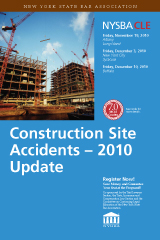Intoxication of Construction Worker who fell from scaffold suffering personal injury held not admissible and not Sole Proximate Cause of Accident
In Jose Miguel Moran v 200 Varick Street Associates, LLC, et al., 80 A.D.3d 581; 914 N.Y.S.2d 307, The Court granted the plaintiff’s motion for summary judgment on his 240(1) cause of action. The plaintiff suffered injury when he fell from a scaffold that lacked proper safety railings. Of particular interest is The Court’s holding regarding intoxication of the injured worker;
“The evidence that the plaintiff was not engaged in a statutorily protected activity or was intoxicated was not admissible (see Zuckerman v City of New York, 49 NY2d 557, 563, 404 N.E.2d 718, 427 N.Y.S.2d 595; Maniscalco v Liro Eng’g Constr. Mgt., 305 A.D.2d 378, 380, 759 N.Y.S.2d 163; Madalinski v Structure-Tone, Inc., 47 AD3d at 688). Moreover, since the scaffold lacked safety railings, the defendant’s alleged intoxication was not the sole proximate cause of his injuries (see Bondanella v Rosenfeld, 298 AD2d 941, 942, 747 N.Y.S.2d 645; Podbielski v KMO-361 Realty Assocs.., 294 A.D.2d 552, 553-554, 742 N.Y.S.2d 664; Sergeant v Murphy Family Trust, 284 AD2d 991, 992, 726 N.Y.S.2d 537).”
The New York Construction Accident Lawyers at Gair, Gair, Conason, Rubinowitz, Bloom, Hershenhorn, Steigman & Mackauf have years of experience representing construction workers who have suffered injury in construction accidents in New York.
 New York Personal Injury Attorneys Blog
New York Personal Injury Attorneys Blog


 The New York State Bar Association has chosen
The New York State Bar Association has chosen 